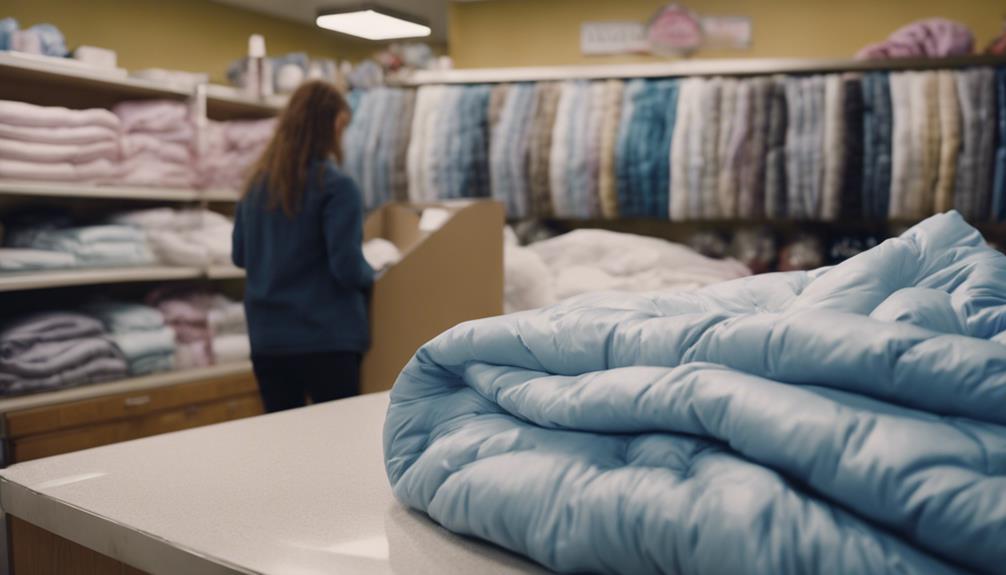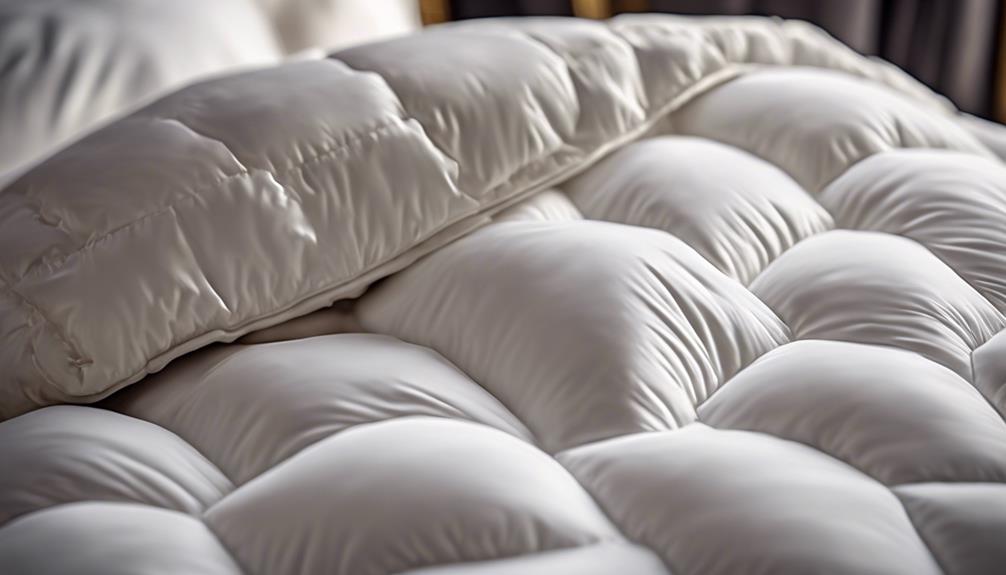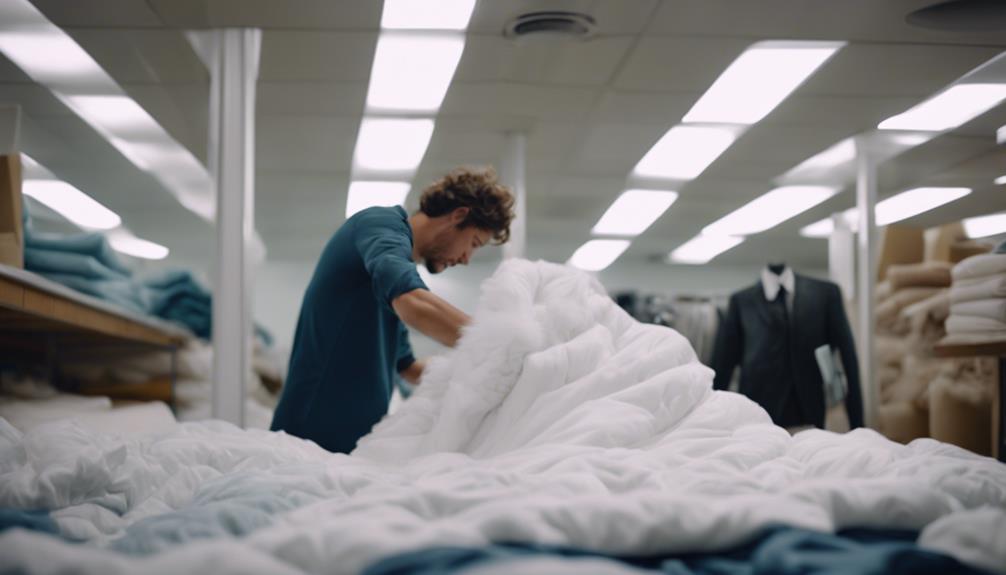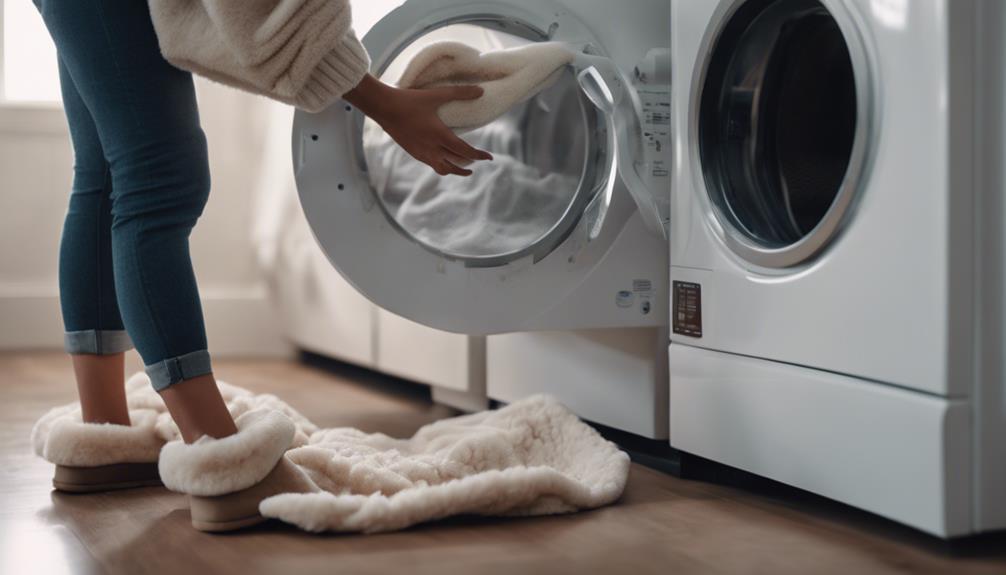When having a down comforter professionally cleaned, you can expect to pay between $30 to $50, depending on factors such as size, materials, and any special treatments required. The final price may be influenced by location and the equipment used for cleaning. Several elements contribute to the overall cost, including supplies, labor, and taxes. Pricing is also impacted by the size of the comforter: crib sizes typically range from $20 to $40, queen sizes from $30 to $50, and king sizes from $40 to $60. Different materials may incur higher costs due to their specific cleaning requirements. To gain a better understanding of pricing and cost factors, you may want to explore alternative cleaning methods to preserve the quality of your comforter.
Key Takeaways
- Size greatly impacts cost; king comforters range from $40-$60.
- Material type affects pricing; delicate fabrics like down may cost more.
- Location plays a role; urban areas may have higher prices.
- Additional charges for special treatments may apply.
- Equipment used by dry cleaners influences overall cost.
Dry Cleaning Cost Overview
When considering the cost of dry cleaning a down comforter, it typically ranges between $30 to $50. Factors such as size, materials, and location play a significant role in determining the final price. The process of dry cleaning a down comforter involves special care due to the delicate nature of the materials. Apart from the base cost, additional charges may apply for services like mending holes or special treatments during the cleaning process. Various components contribute to the total cost, including cleaning supplies, labor, service fees, and taxes.
The type of materials used in the comforter also affects the cost of dry cleaning. Different materials may require specific treatments or cleaning processes, leading to variations in pricing. Additionally, the equipment and machines used by the dry cleaning service can impact the overall cost. Understanding these factors can help in making an informed decision when it comes to maintaining the cleanliness of your down comforter.
Size Impact on Cost
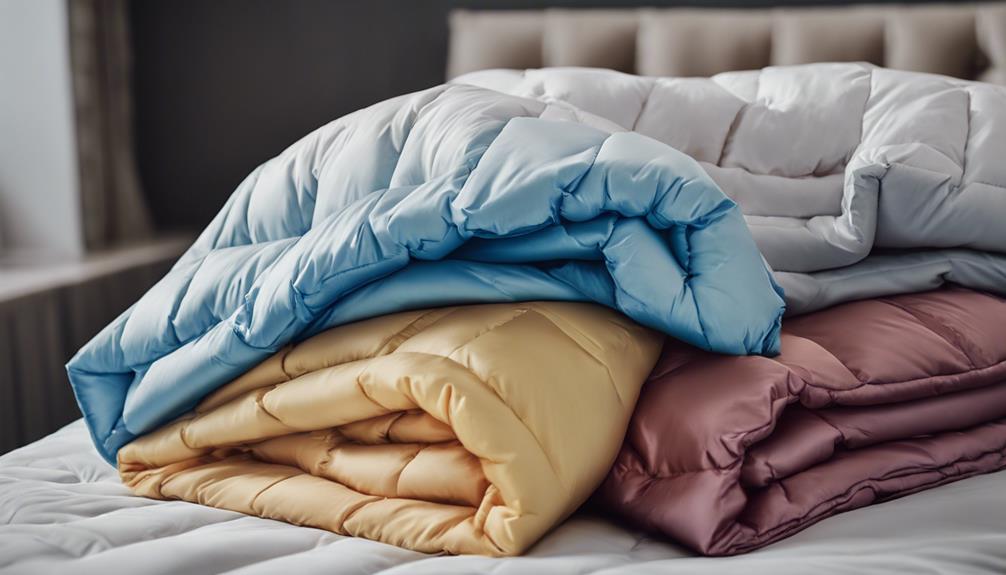
Size plays an essential role in determining the cost of dry cleaning a down comforter. The larger the comforter, the higher the cost due to the increased use of cleaning supplies and labor. Below is a table illustrating how the size of a down comforter impacts the dry cleaning cost:
| Size | Approximate Cost |
|---|---|
| Crib | $20-$40 |
| Queen | $30-$50 |
| King | $40-$60 |
As shown in the table, the cost range for dry cleaning a down comforter increases as the size goes up. Crib size comforters are generally the least expensive to clean, while king size comforters tend to be the most costly. When considering dry cleaning costs for your down comforter, keep in mind that the size of the comforter is a critical factor influencing the total cost.
Material Type Considerations
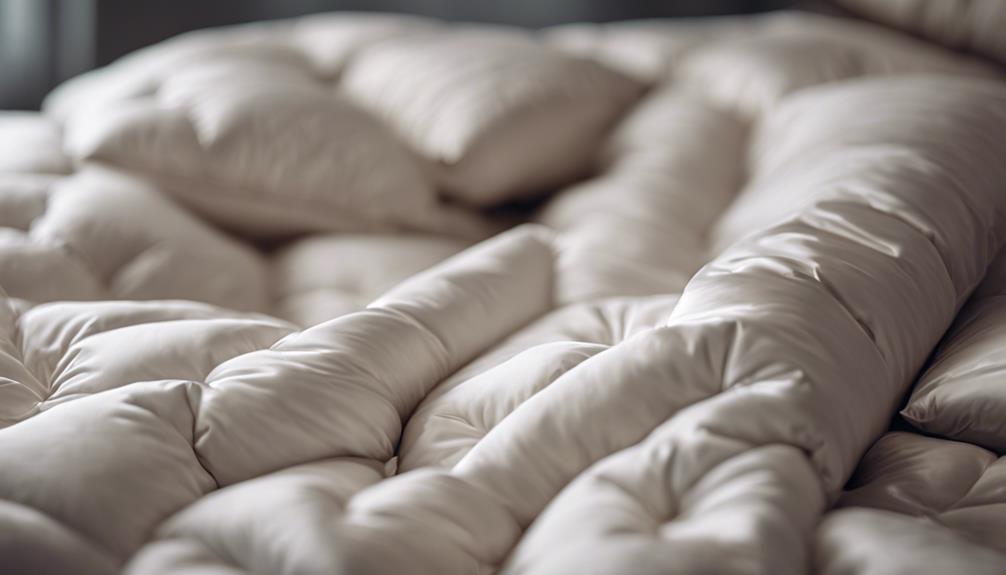
Considering the fabric composition of your down comforter is vital for evaluating its dry cleaning requirements and associated costs. Different material types impact the price of dry cleaning. Delicate fabrics like down feathers necessitate special care, potentially increasing the overall cost. Synthetic materials generally cost less to dry clean than natural fibers such as wool.
If you have a wool down comforter, be prepared for a potentially higher dry cleaning expense due to the specific handling needed for natural fibers. It's important to understand the material type of your comforter to determine the appropriate dry cleaning process and cost. By recognizing the fabric composition, you can make sure that your down comforter receives the proper care it needs during dry cleaning, ultimately affecting the total expense.
Make an informed decision based on the material type to maintain the quality of your comforter without overspending on the cleaning process.
Equipment Influence on Pricing
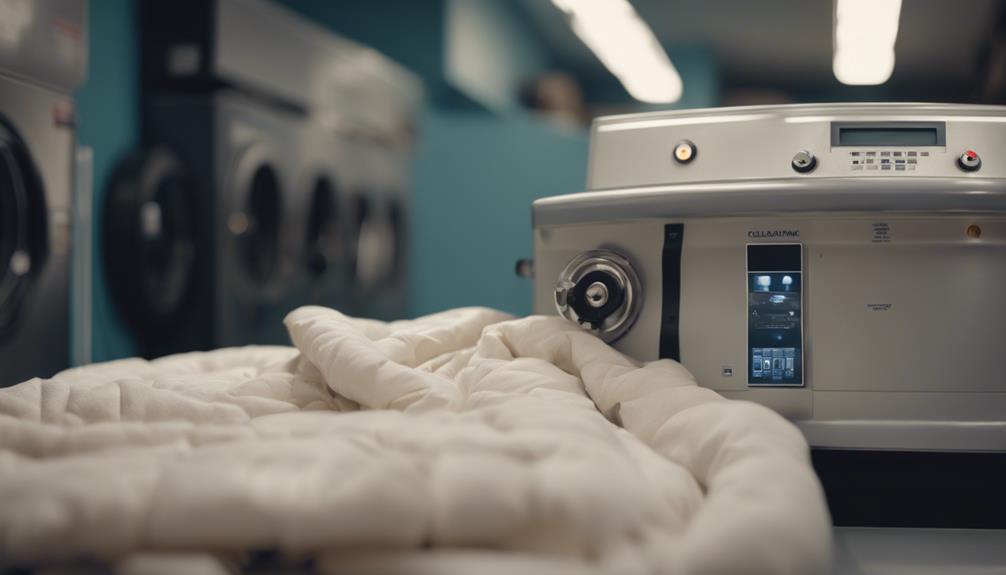
Specialized equipment used in dry cleaning services can impact the pricing for cleaning a down comforter. Modern machines or specific technology utilized by dry cleaners may result in additional costs for customers seeking to clean their comforters. Some dry cleaners invest in advanced machines that offer enhanced cleaning capabilities, which could lead to higher prices for comforter cleaning. The type of equipment employed plays a significant role in determining the overall cost of the service. Different machine options available at dry cleaning facilities can influence the pricing structure for cleaning a down comforter.
| Types of Equipment | Pricing Impact |
|---|---|
| Advanced Machines | Higher cost |
| Specialized Technology | Additional charges |
| Upgraded Systems | Increased pricing |
| Specific Machines | Costlier service |
| Modern Equipment | Price may vary |
Location's Cost Variability

Location plays a significant role in the cost of dry cleaning a down comforter. Regional price differences, local service availability, and competitive pricing strategies all contribute to the variability in pricing.
It's essential to research and compare prices at different establishments in your area to find the most cost-effective option.
Regional Price Differences
When exploring the cost of dry cleaning a down comforter, it becomes evident that regional price discrepancies play a significant role in determining the overall expense. Prices for washing a down comforter can range from $30 to $50, but these costs aren't fixed and can vary depending on the region where you live.
Urban areas with higher living standards tend to have higher dry cleaning costs compared to rural areas. Even within the same city, different dry cleaning establishments may charge varying prices for cleaning down comforters. Factors such as overhead expenses and labor costs influence these regional differences.
To get the best deal for dry cleaning your down comforter, it's advisable to compare prices from multiple dry cleaners in your area.
Local Service Availability
Given the fluctuating cost of dry cleaning a down comforter depending on location, it's important to understand how local service availability can impact the overall pricing. Some areas may have limited options when it comes to professional dry cleaning services, leading to higher costs due to less competition.
In contrast, regions with several dry cleaning businesses may offer more competitive pricing strategies. It's important to evaluate if the comforter is machine washable, as this could influence where you decide to wash a down comforter.
Being aware of the availability of local services and their rates can help you make an informed decision on where to take your down comforter for cleaning.
Competitive Pricing Strategies
Understanding the competitive pricing strategies for dry cleaning a down comforter involves considering the variability in costs based on different locations. The cost of cleaning a comforter can range from $30 to $50, influenced by factors like the area's living standards. Higher-end locations might charge more for their services.
Material quality and the equipment used by the dry cleaner also play a role in determining the overall price. Additional services such as repairing holes or applying special treatments may come with extra charges on top of the standard cleaning fee.
To reduce costs, one could explore discounts, membership services, or alternative cleaning methods. Researching and comparing prices is crucial to find the best deal for cleaning your comforter.
Machine Wash as Cost-Saving Option
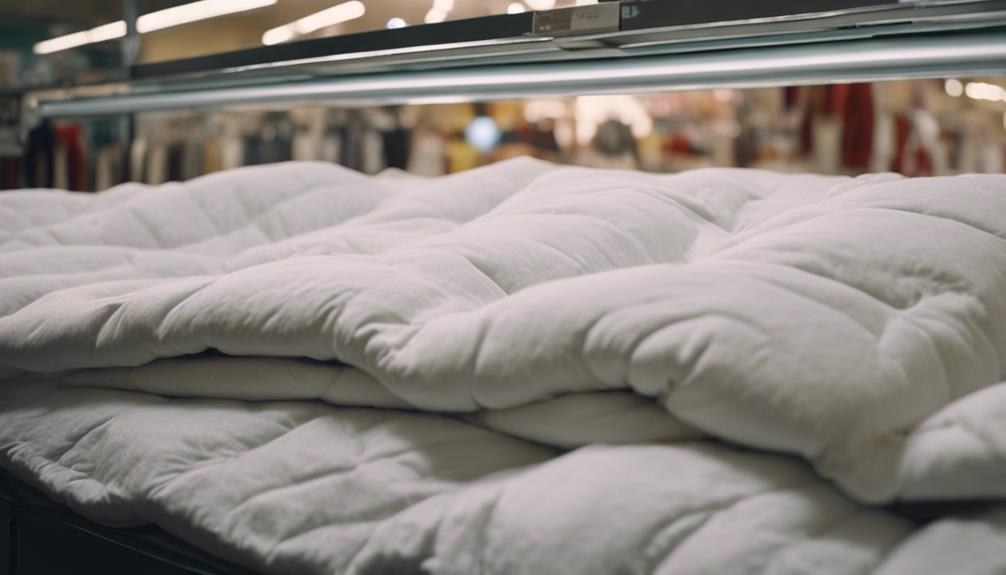
To save on costs, consider machine washing your down comforter at home following the care label instructions carefully. Using a front-loading washer with a gentle cycle is recommended for cleaning your comforter effectively. This cost-saving option can help you avoid the higher prices of professional dry cleaning services.
By washing your down comforter at home, you not only save money but also guarantee that it's cleaned to your satisfaction. Properly drying the comforter after machine washing is vital to maintain its quality and freshness. Make sure to follow the care label instructions closely to prevent any damage during the washing process.
With a front-loading machine and a gentle cycle, you can enjoy the convenience and cost-effectiveness of cleaning your down comforter at home. Remember, always prioritize the care and maintenance of your comforter to prolong its lifespan and keep it in top condition.
DIY Dry Cleaning Techniques
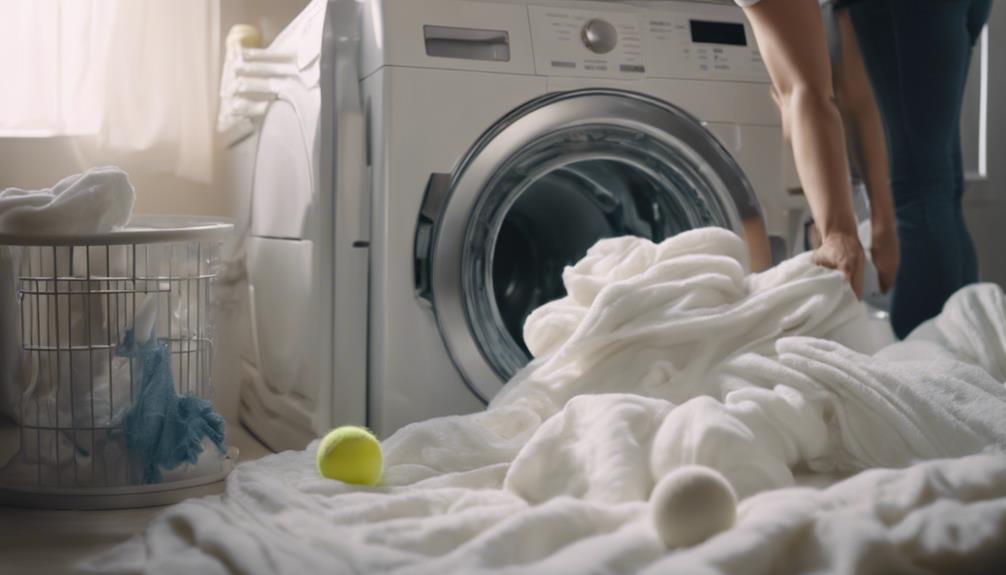
Using a DIY dry cleaning kit for your down comforter can be a cost-effective and convenient way to maintain its cleanliness and freshness. Here are three key points to keep in mind when opting for DIY dry cleaning:
- Carefully follow the instructions provided in the kit to make sure your down comforter is effectively dry cleaned.
- Utilize a large capacity front-loading washer for the best results in cleaning your comforter at home.
- Regular use of DIY dry cleaning kits not only saves you money in the long run but also helps in extending the lifespan of your down comforter.
Cost-Effective Service Support

Seeking discounts as regular customers can greatly reduce the costs associated with dry cleaning services. Membership services may offer deals on dry cleaning, providing a cost-effective approach to maintaining your down comforter. Additionally, cost-effective service support can help lower the overall expenses related to dry cleaning. Consider using specialized kits for DIY cleaning at home as a more budget-friendly option. Checking product tags for washing alternatives can also help avoid expensive dry cleaning services. Here is a comparison table highlighting the benefits of cost-effective service support:
| Service Support Option | Benefits |
|---|---|
| Regular Customer Discounts | Reduced Costs |
| Membership Deals | Cost Savings |
| DIY Cleaning Kits | Budget-Friendly Solution |
Alternative Cleaning Methods
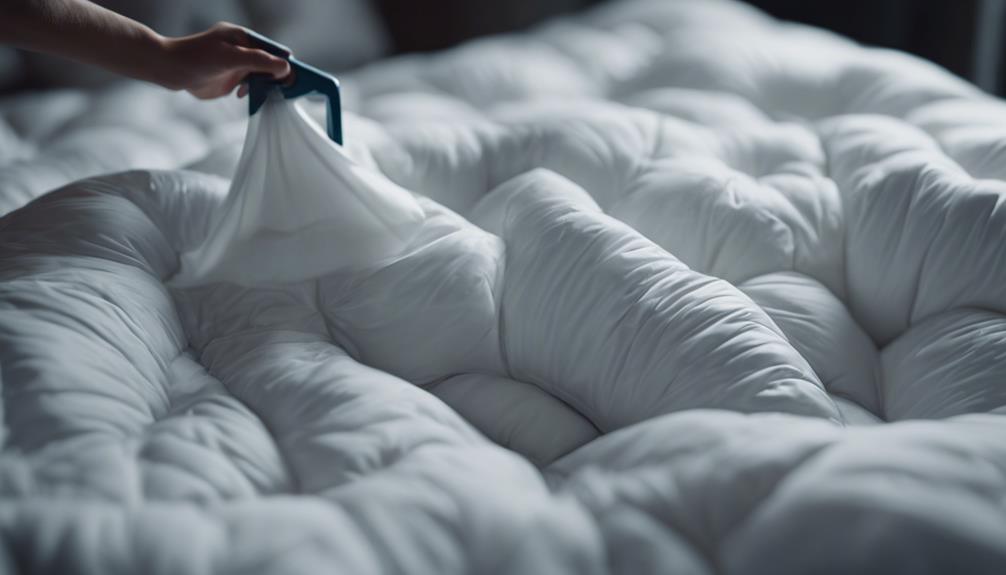
Exploring unconventional approaches to cleaning can offer practical solutions for maintaining a down comforter. When it comes to alternative cleaning methods, there are a few tricks that can help keep your comforter fresh and fluffy:
- Clean Tennis Balls: Tossing a few clean tennis balls into the dryer with your comforter can help fluff up the feathers and prevent clumping during the drying process.
- Low Heat Setting: Opting for a low heat setting when drying your comforter can prevent damage to the delicate feathers while still ensuring thorough drying.
- Air Fluff Cycle: Using the air fluff cycle on your dryer without any heat can help aerate the comforter and remove any excess moisture without subjecting it to high temperatures.
King Size Comforter Cleaning Cost
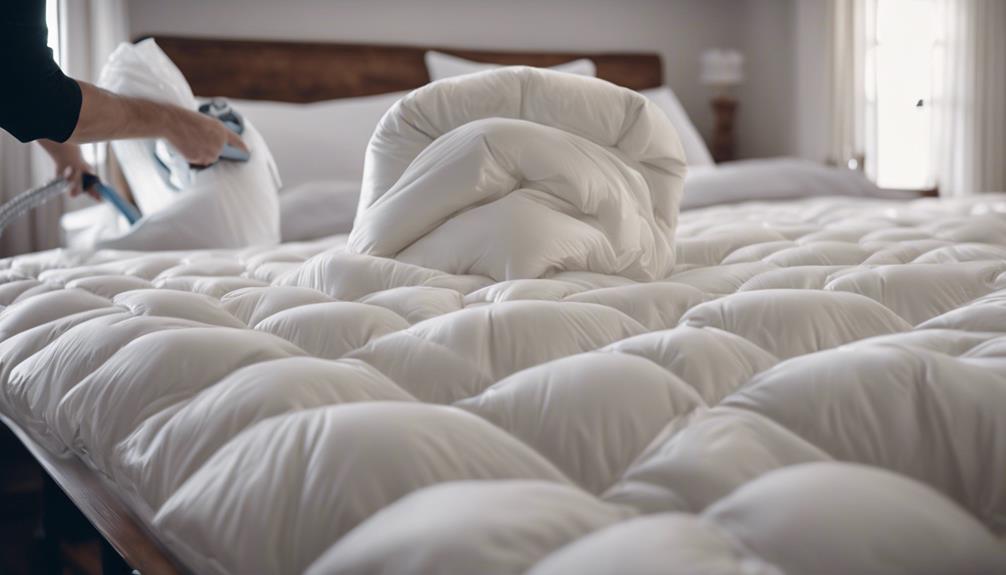
When considering the cost of cleaning a king size comforter, it's important to compare prices from different dry cleaners to find the best deal.
Factors like the location of the cleaner, the materials of the comforter, and any special cleaning requirements can all influence the final cost.
Understanding these factors can help us make informed decisions when it comes to maintaining and cleaning our king size comforters.
King Comforter Pricing Comparison
Comparing the pricing for cleaning king size comforters, one can expect the cost to range from $30 to $50, with additional fees possible for special services. When evaluating the cost of cleaning a king size comforter, it's crucial to weigh the options available to guarantee the best value. Here are some key points to keep in mind:
- Different dry cleaners may offer varying pricing structures, so it's wise to shop around.
- Some cleaners might include extra services in their base price, such as stain removal or repairs.
- Keep in mind that the quality of service and expertise provided can also impact the overall value of the cleaning process.
Factors Affecting Cleaning Costs
It's crucial to consider factors such as the size of the comforter, material type, equipment utilized, and the dry cleaner's location as they can greatly influence the cost of cleaning a king size comforter.
King size comforters require more cleaning solution and time, leading to higher prices compared to smaller sizes. Delicate materials like silk or down may need special care, further increasing the cost.
The choice of dry cleaner's location matters too; those in upscale areas may charge more. Some dry cleaners use specialized equipment like large washing machines to clean king size comforters efficiently, impacting the overall cost.
To keep costs down, one must follow proper care instructions and choose a dry cleaner that offers competitive pricing for king size comforter cleaning.
Frequently Asked Questions
How Expensive Is It to Dry Clean a Down Comforter?
Dry cleaning a down comforter can be moderately priced, ranging from $30 to $50. Various factors like size, location, and extra services can influence the final cost. The breakdown includes cleaning supplies, labor, services, and taxes.
To save money, one might consider washing at home or opting for non-dry clean bedding. Prices vary, so it's wise to inquire for an accurate estimate before proceeding with the service.
Can Dry Cleaners Clean Down Comforters?
Prior to sending your down comforter for cleaning, it's important to inquire whether the dry cleaners offer such services. Opting for professional laundering is preferable to dry cleaning in order to prevent potential damage caused by harsh chemicals.
The average cost of dry cleaning a comforter ranges from $30 to $60, depending on its size. Although dry cleaning helps prevent shrinkage, it can be detrimental to the down filling due to the use of strong chemicals.
Using a duvet cover can assist in minimizing the need for frequent washing of the comforter, thereby extending its longevity.
Is It Worth Dry Cleaning a Comforter?
Dry cleaning a comforter can be worth it if it's heavily soiled or has delicate materials. Factors like size and services like mending holes can affect costs. Always check the care label first to see if dry cleaning is necessary.
Costs vary depending on location and services offered. To save money, consider alternatives like machine washing or seeking discounts. Evaluate if the benefits of dry cleaning outweigh the costs before deciding.
How Should a Down Comforter Be Cleaned?
Cleaning a down comforter involves dry cleaning every 2-3 times a year. This process includes inspection, spot cleaning, washing with special solvents, temperature-controlled drying, and finishing touches. It's essential to maintain its quality and lifespan.
Dry cleaning costs around $30 to $50, depending on size and additional services. Using chemical solvents in dry cleaning helps preserve the comforter's integrity without damage, ensuring it stays fresh and fluffy.
Conclusion
To wrap up, the cost to dry clean a down comforter can range from $20 to $50, depending on factors such as size, material, and location.
On average, the cost for cleaning a king-size comforter can be around $40.
It's crucial to take into account these factors before deciding on the best cleaning method for your comforter to guarantee its longevity and maintain its quality.
